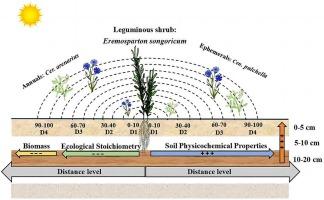The ‘fertilizer island effect’ cannot eliminate competition between leguminous shrubs and symbiotic herbs in desert ecosystems
IF 5.4
1区 农林科学
Q1 GEOSCIENCES, MULTIDISCIPLINARY
引用次数: 0
Abstract
The ‘fertilizer island effect’ — a phenomenon engendered by shrubs — promotes the growth of symbiotic herbs and the stabilization of community structures in scrublands. Specifically, leguminous shrubs contribute significantly to the nitrogen input in desert ecosystems. However, the impact of these inputs on the nutrient balance in symbiotic herbs has seldom been explored. To enhance our understanding of the nutrient balance between nitrogen-fixing legume shrubs and symbiotic non-legume herbaceous plants in desert ecosystems, we focused on a typical legume shrub (Eremosparton songoricum) that grows in the Gurbantunggut Desert of northern China. Subsequently, we examined the biomass, ecological stoichiometry, and rhizosphere soil properties of two plant species (annual plant: Ceratocarpus arenarius; and ephemeral plant: Centaurea pulchella) growing across four horizontal distance ranges from E. songoricum. The results indicated that the closer a herbaceous plant was to the leguminous shrubs, the lower was its biomass and nutrient content. In contrast, herbaceous plants growing further away from the shrubs exhibited better growth conditions. The total biomass of Cer. arenarius and Cen. pulchella was greatest at a distance of D4 (90–100 cm), being 3.07, 2.15, and 1.23 times higher for Cer. arenarius and 2.05, 1.18, and 1.26 times higher for Cen. pulchella compared to distances of D1 (0–10 cm), D2 (30–40 cm), and D3 (60–70 cm), respectively. Meanwhile, the physicochemical properties of the rhizosphere root varied inversely with distance, with nutrient levels decreasing horizontally from D1 to D4 and vertically from 0–5 cm > 5–10 cm > 10–20 cm, showcasing a distinct ‘fertilizer island effect’. As the distance increased, the above-ground and below-ground parts of the symbiotic non-leguminous plants started to rely on different types of soil nutrients from different depths to maximize nutrient acquisition. According to the structural equation model, although soil fertility was higher closer to the central leguminous plants, the biomass of nearby herbaceous plants was lower. In summary, in desert ecosystems, the competitive dynamics exerted by leguminous shrubs significantly overshadowed the nutrient provisioning role of the ‘fertilizer island effect’. Furthermore, the utilization of nutrients by symbiotic non-leguminous plants did not exhibit species-specific patterns, and the dominant shrub continued to play a pivotal role. The evidence from this study promotes a deeper understanding of species coexistence mechanisms and ecological stability in desert environments.

肥岛效应 "无法消除沙漠生态系统中豆科灌木和共生草本植物之间的竞争
灌木产生的 "肥岛效应 "促进了共生草本植物的生长和灌丛地群落结构的稳定。具体来说,豆科灌木对沙漠生态系统的氮输入贡献巨大。然而,这些输入对共生草本植物养分平衡的影响却很少被研究。为了加深我们对荒漠生态系统中固氮豆科灌木与共生非豆科草本植物之间养分平衡的了解,我们重点研究了生长在中国北方古尔班通古特沙漠中的一种典型豆科灌木(Eremosparton songoricum)。随后,我们研究了两种植物(一年生植物:Ceratocarpus arenar)的生物量、生态化学计量和根圈土壤特性:Ceratocarpus arenarius;昙花一现的植物:在四个水平距离范围内生长的两种植物(一年生植物:Ceratocarpus arenarius;昙花一现的植物:Centaurea pulchella)。结果表明,草本植物离豆科灌木越近,其生物量和养分含量就越低。相反,离灌木越远的草本植物生长状况越好。与 D1(0-10 厘米)、D2(30-40 厘米)和 D3(60-70 厘米)的距离相比,Cer. arenarius 和 Cen. pulchella 在距离 D4(90-100 厘米)处的总生物量最大,分别是 D1(0-10 厘米)、D2(30-40 厘米)和 D3(60-70 厘米)处的 3.07 倍、2.15 倍和 1.23 倍。同时,根瘤根的理化性质与距离成反比变化,养分含量从 D1 到 D4 水平递减,从 0-5 cm > 5-10 cm > 10-20 cm 垂直递减,表现出明显的 "肥岛效应"。随着距离的增加,共生非豆科植物的地上部分和地下部分开始依赖来自不同深度的不同类型的土壤养分,以最大限度地获取养分。根据结构方程模型,虽然靠近中心豆科植物的土壤肥力较高,但附近草本植物的生物量却较低。总之,在荒漠生态系统中,豆科灌木的竞争动力大大超过了 "肥岛效应 "的养分供应作用。此外,共生非豆科植物对养分的利用并没有表现出物种特异性,优势灌木继续发挥着关键作用。这项研究的证据有助于加深对沙漠环境中物种共存机制和生态稳定性的理解。
本文章由计算机程序翻译,如有差异,请以英文原文为准。
求助全文
约1分钟内获得全文
求助全文
来源期刊

Catena
环境科学-地球科学综合
CiteScore
10.50
自引率
9.70%
发文量
816
审稿时长
54 days
期刊介绍:
Catena publishes papers describing original field and laboratory investigations and reviews on geoecology and landscape evolution with emphasis on interdisciplinary aspects of soil science, hydrology and geomorphology. It aims to disseminate new knowledge and foster better understanding of the physical environment, of evolutionary sequences that have resulted in past and current landscapes, and of the natural processes that are likely to determine the fate of our terrestrial environment.
Papers within any one of the above topics are welcome provided they are of sufficiently wide interest and relevance.
 求助内容:
求助内容: 应助结果提醒方式:
应助结果提醒方式:


